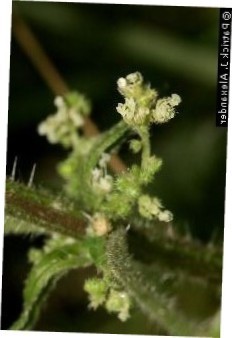Stinging Nettle
(Urtica chamaedryoides chamaedryoides)

Description
Urtica is a genus of flowering plants in the family Urticaceae. Many species have stinging hairs and may be called nettles or stinging nettles, although the latter name applies particularly to Urtica dioica. Urtica species are food for the caterpillars of numerous Lepidoptera (butterflies and moths), such as the tortrix moth Syricoris lacunana and several Nymphalidae, such as Vanessa atalanta, one of the red admiral butterflies. Urtica species grow as annuals or perennial herbaceous plants, rarely shrubs. They can reach, depending on the type, location and nutrient status, a height of 10–300 centimetres (3.9–118.1 in). The perennial species have underground rhizomes. The green parts have stinging hairs. Their often quadrangular stems are unbranched or branched, erect, ascending or spreading. Most leaves and stalks are arranged across opposite sides of the stem. The leaf blades are elliptic, lanceolate, ovate or circular. The leaf blades usually have three to five, rarely up to seven veins. The leaf margin is usually serrate to more or less coarsely toothed. The often-lasting bracts are free or fused to each other. The cystoliths are extended to more or less rounded. In 1874, while in Collioure (south of France), French botanist Charles Naudin discovered that strong winds during 24 hours made the stinging hairs of Urtica harmless for a whole week. A large number of species included within the genus in the older literature are now recognized as synonyms of Urtica dioica. Some of these taxa are still recognized as subspecies. Due to the stinging hairs, Urtica species are rarely eaten by herbivores, but rather provide shelter for insects, such as aphids, butterfly larvae, and moths. Fabric woven of nettle fiber was found in burial sites in Denmark dating to the Bronze Age, and in clothing fabric, sailcloth, fishing nets, and paper via the process called retting (microbial enzymatic degradation, similar to linen processing). Other processing methods include mechanical and chemical. In New Zealand, U. ferox is classified among poisonous plants, most commonly upon skin contact. Urtica, called kopriva in Russian, Croatian, Serbian, Bulgarian and Slovenian, and urzica in Romanian, is an ingredient in soups, omelettes, banitsa, purée, and other dishes. In Mazandaran, northern Iran, a soup (Āsh) is made using this plant. Nettles were used in traditional practices to make nettle tea, juice, and ale, and to preserve cheeses, such as in Cornish Yarg.
Taxonomic tree:







